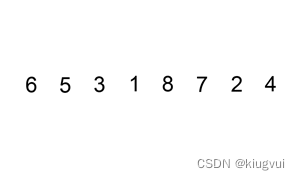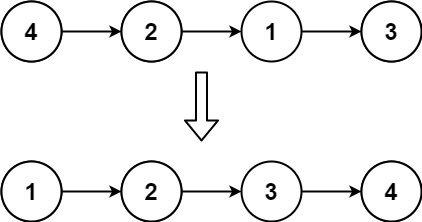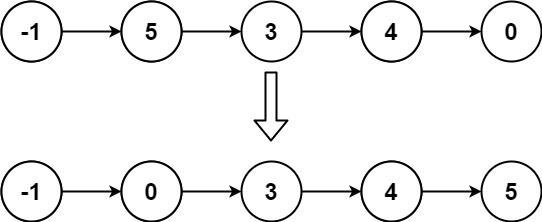给定单个链表的头 head ,使用 插入排序 对链表进行排序,并返回 排序后链表的头 。
插入排序 算法的步骤:
- 插入排序是迭代的,每次只移动一个元素,直到所有元素可以形成一个有序的输出列表。
- 每次迭代中,插入排序只从输入数据中移除一个待排序的元素,找到它在序列中适当的位置,并将其插入。
- 重复直到所有输入数据插入完为止。
下面是插入排序算法的一个图形示例。部分排序的列表(黑色)最初只包含列表中的第一个元素。每次迭代时,从输入数据中删除一个元素(红色),并就地插入已排序的列表中。
对链表进行插入排序。

示例 1:

输入: head = [4,2,1,3] 输出: [1,2,3,4]
示例 2:

输入: head = [-1,5,3,4,0] 输出: [-1,0,3,4,5]
解法一
所谓的插入排序,就是一次拿一个数把它插入到正确的位置。
举个例子。
4 2 1 3
res = []拿出 4
res = [4]拿出 2
res = [2 4]拿出 1
res = [1 2 4] 拿出 3
res = [1 2 3 4]
用代码的实现的话,因为要拿出一个要插入到已经排好序的链表中,首先肯定是依次遍历链表,找到第一个比要插入元素大的位置,把它插到前边。
至于插入的话,我们需要知道插入位置的前一个节点,所以我们可以用 node.next 和要插入的节点比较,node 就是插入位置的前一个节点了。
而 head 指针已经是最前了,所以我们可以用一个 dummy 指针,来将头指针的情况统一。
public ListNode insertionSortList(ListNode head) {if (head == null) {return null;}ListNode dummy = new ListNode(0);//拿出的节点while (head != null) {ListNode tempH = dummy;ListNode headNext = head.next;head.next = null; while (tempH.next != null) {//找到大于要插入的节点的位置if (tempH.next.val > head.val) {head.next = tempH.next;tempH.next = head; break;}tempH = tempH.next;}//没有执行插入,将当前节点加到末尾if (tempH.next == null) {tempH.next = head;}head = headNext;}return dummy.next;
}
这里-space-) 还有另一种写法,分享一下。
public ListNode insertionSortList(ListNode head) {if( head == null ){return head;}ListNode helper = new ListNode(0); //new starter of the sorted listListNode cur = head; //the node will be insertedListNode pre = helper; //insert node between pre and pre.nextListNode next = null; //the next node will be inserted//not the end of input listwhile( cur != null ){next = cur.next;//find the right place to insertwhile( pre.next != null && pre.next.val < cur.val ){pre = pre.next;}//insert between pre and pre.nextcur.next = pre.next;pre.next = cur;pre = helper;cur = next;}return helper.next;
}
 原创 Yutao Cui等 AI生成未来)

)






![[uni-app ] createAnimation锚点旋转 及 二次失效问题处理](http://pic.xiahunao.cn/[uni-app ] createAnimation锚点旋转 及 二次失效问题处理)

等级考试试卷(一级))


)
)


